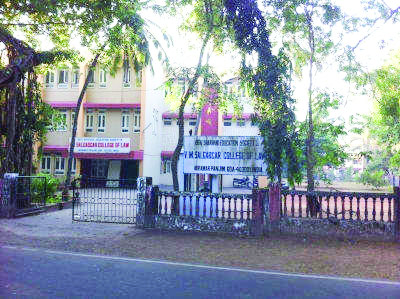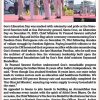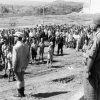Goa is abuzz with excitement as vintage bike and car owners, users, collectors and fans are decking […]

PIONEERS OF GOAN INDUSTRY!
01 Nov- 08 Nov 2019, In Goa November 1, 2019GENEROUS: Realizing the need for a law college it was the late VM Salgaocar who started the Salgaocar Law College in Miramar, Panjim
By Rajan Narayan
While the pioneers of industry in Goa were very generous and fully conscious of their corporate social responsibility, Gen Next is not even willing to pay part of the salaries of mine workers who helped them make billions during the Chinese iron ore boom
The pioneers of Goan Industry have mainly been mine owners. When the Portuguese discovered there was iron ore in the hills of Goa, they issued literally hundreds of leases. Most of them were not worked on as ore content was too low to make it profitable. Most businessmen in Goa preferred the easier option of trading which was very attractive as before Liberation custom duties were very low and Goa was known as the Dubai of India.
Only a few hardened souls ventured into mining which was hard work involving prospecting through the then extremely backward rural areas of Goa in bullock carts, identifying workable leases and extracting ore with hammers. Finally, there were just five or six big industrialists left, with the late VM Salgaocar leading the list. VM Salgaocar, who started off with a small shop in Ribandar, graduated to wholesale trade in vegetables and finally established himself through very hard work as a mining baron. He was among the big five of mining. The others who had the grit to continue and build huge mining empires were VD Chowgule from Belgaum, who like VM Salgaocar came up through very hard work, the Timblos from Margao, the Bandekars of Vasco and the Dempos of Panjim.
A major factor in their success was the fact that they discovered they could use barges to transport ore from the mining points to the MPT from where it was exported. Even so, the fact that iron content in Goan ore ranged between 55% and 58% and the ore was in powder form, meant that margins were not very big. Primarily Goan ore was exported to Japan and Korea.
The only consumer industry that was started in Goa post-Liberation was by the CMM group of companies headed by Pascoal Jose Menezes. Pascoal had been offered the opportunity of joining the mining business by his good friend VM Salgaocar. But not for Pascoal all the dirt and coal. Pascoal preferred manufacture and as a special concession the Union government granted licenses to CMM to manufacture foreign brands in collaboration with international companies. Indeed industrial licenses one two and three all stand in the name of the CMM group. This included the licenses for manufacturing drugs with Carter Wallace, band aids in collaboration with Earle Dickson, and the very popular cologne, Old Spice.
The old time pioneering industrialists were a generous bunch. They believed in corporate social responsibility long before it became compulsory. In any case they had to take care of the health and the education of the thousands of workers who extracted ore for them in very difficult conditions.
Most of the early health-care facilities in the state were set up by the mining barons. The first of them to realize the need for a full-fledged hospital was the late VM Salgaocar who started the Salgaocar Medical Centre. Among the non-mining industrialists, Pascoal Menezes set up the first nursing home, namely the CMM Polyclinic at Altinho.
During Portuguese colonial rule there were no educational facilities at all. You could study up to the tenth standard at the most and that too in Portuguese. There were a few Marathi schools started by the bhatkars (land owners). The first Arts & Science college set up in the state was by the Dempos. The college was inaugurated just a year after Liberation in June 1962 by the late Vasuntrao Dempo who was the backbone of the Dempo empire. Since Goa did not have a law college despite the large number of cases, VM Salgaocar simultaneously set up a law college called the VM Salgaocar Law College. Interestingly, they were side by side in Miramar in Panjim. In the Dempo family, Shrinivas Dempo has continued the tradition of giving back to society by supporting sports persons.
VM Salgaocar was not only amongst the most generous mine owners but a true Goan who staked the future of his industrial empire on the outcome of the Opinion Poll. During the battle of the Opinion Poll, it was VM Salgaocar who financed the anti-merger campaign despite lures and threats from senior Maharashtrian leaders.
In Vasco da Gama the most generous mine owner was Nana Bandekar. Nana has contributed more to the development of Vasco city than all the Municipal corporations put together. If Vasco has broad roads and an excellent crematorium it is thanks to Nana who never said no to any charitable cause.
Among the second generation of industrialists mention must be made of Anil Khaunte who resigned his job as junior engineer in the Electricity Department and with Victor Albuquerque got into construction. In the ‘80s when I came to Goa the only reputed builders in North Goa were Alcon and the Kamats.
Anil Khaunte never talks about his charities in the spirit that the left hand should not know what the right gives. It is Anil Khaunte who built up the Mushtifund Saunstha into the most successful educational institution in the State. It was Anil who thought of collaborating with an IIT training institution to prepare Goans for competitive exams. Anil is also the chairman of the Disha Trust which runs schools for differently-abled children.
Unlike the first generation of Goan industrialists who did a great deal for the community, most of generation-next have been extremely selfish and self-centred. Generation next seems to be only interested in making money. They have not displayed any sense of social responsibility. With the exception of Srinivas Dempo, who made a major contribution to sports, and VM Salgaocar’s son Dattaraj, none of the children of the industrial giants have sought to perform their corporate social responsibility. Adding to the college that his father started, Dattaraj Salgaocar took over the Sharda Mandir School and has brought it up to international standards. To promote art and culture he started Sunaparanta at Altinho. The publishing group ‘Goa Publications’ is owned by Dattaraj Salgaocar who published a table top book on the history of Goa and a book on the battle of the Opinion Poll called ‘Triumph of Secularism’ by Sharon D’Cruz and Rajan Narayan.
Perhaps the saddest part of the lack of any sense of charity on the part of mine owners is the manner in which the mining barons have treated mining employees. It is now more than a decade since mining was suspended by the Supreme Court. Mining was suspended as the Shah Committee, appointed by the Supreme Court, established that the mining industry had committed illegalities which had cost Goa and the Centre more than `35,000 crore while making huge profits during the Chinese boom when the cost of iron ore went up from $20 to $200 plus per ton. Logically the mining industry which made huge amounts of money by cheating should look after the mining employees. Instead, it has used its political clout to get the government to compensate mining dependents.
Former mining employees who have been sacked continue to get assistance from the government. Barge owners have been extended help to repay loans. Those who hired machinery and gave it on lease to the mining industry also have undergone huge losses. Yes, even Chief Minister Pramod Sawant, who represents Sanquelim constituency, a major mining belt, has not forced the mining industry to come to the help of the workers and other dependents who helped earn billions.
On the contrary the mining barons have closed down the schools, stopped transport and even closed the health centers that they used to run in the mining areas. Even the mining pits were not sealed properly, resulting in loss of lives by drowning. Which is not surprising as Gen Next is far too selfish to think of anyone else but themselves.
DISPARITY OF WAGES
Disparity in wages between the rich and the poor is not unique to Goa and India. Indeed it is a worldwide phenomenon. A major reason is the growth of IT which is much less labour intensive than manufacturing. The world over manufacturing has undergone a major change. Increasingly, manufacturing is being automated, with robots replacing human beings.
A number of administrative jobs which involved individual effort have now also been automated. The number of bank employees have sharply reduced with the very fast development of ATMs and electronic transfers. The greatest drop in employment is in public sector in India with automation of even mundane tasks like issuing of birth and death certificates. There will be soon no need for a registrar of land records and a civil registrars office as it can be made available online.
Thanks to the GPS system you do not need either lakhs of human beings or physical mapping of geographical areas. Even in Goa there are plans to upload all the land survey maps on a special website, so that not only are claims to ownership confirmed but disputes can be minimized.
Blue collar jobs, i.e. jobs in manufacture, have already diminished a great deal. Now it is the turn of white collar jobs. There may come a time when transport might become redundant as all communication can be done online. In fact with artificial intelligence you may not even have to think, as machines will do most routine jobs for you.
IT EMPOWERMENT
The IT revolution has empowered the lowest sections of society. The smart phone does not distinguish between a PHD and a 10th standard pass. In fact it is been found that the semi-literate make better IT workers than the highly literate. Coding for instance does not require expertise in the nuances of English or any other language. What it demands is a high degree of logic and an ability to concentrate.
The main concern is whether the number of jobs will reduce in absolute terms. This is unlikely as any new technology will require additional workers to function. However income inequality will drop as more and more of the population become not literate in a conventional sense but computer literate.















